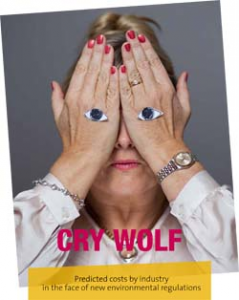
As awareness continues to grow about the impacts of business on people and the environment around the world, companies and trade organizations resort to the old argument that stricter environmental regulations would stymie the economy. Truth be told, studies show that this argument is simply not the case.
 In an effort to refrain from having to adapt their products, industry groups frequently overestimate the costs of adapting to legislation that is more protective of people and the environment, and underestimate the anticipated profits.
In an effort to refrain from having to adapt their products, industry groups frequently overestimate the costs of adapting to legislation that is more protective of people and the environment, and underestimate the anticipated profits.
As a case in point, ChemSec’s report Cry Wolf uses past experiences with public health and environmental policy adaptations to show the fallacy of this argument. ChemSec compares initial industry estimates for the cost of the legislation born by industry against the actual costs incurred. The results clearly indicate industry’s tendency to “cry wolf” when the pastures really are quite safe. The research shows that the economy is much more innovative and adaptive to progressive change than industry is willing to admit and project.
According to ChemSec, industries resist “wolf-ish” regulations by:
- developing static, limited cost models
- ignoring cost reductions that accompany regulation compliance
- underestimating benefits under new policies
Among a number of examples that Cry Wolf investigates is the financial impact of pesticide regulations on farmers — a timely topic in the midst of the current US-EU trade agreement negotiations underway in which the pesticide industry proposes to use the trade deal to lower levels of protection. Numerous chemicals used in pesticides have been linked to harmful effects on human and environmental health; particularly worrisome are endocrine (hormone) disrupting chemicals (EDCs), which interfere with the normal function of the endocrine system, and are linked to adverse effects on the reproductive, cognitive, metabolic, and respiratory systems, among others. Also of concern are carcinogens and toxic pollutants, for their health impacts and the ecological damage caused by irrigation run-off. Evidence shows that industry is trying to exploit differences on both sides of the Atlantic to weaken protections (see Toxic Partnership and Lowest Common Denominator).
Pesticide manufacturers are, predictably, wary of new regulations on the products that they sell. Their lobbying efforts typically include predictions of enormous crop losses that would, in their view, manifest if agricultural producers could not use the hazardous pesticides that they sell. CropLife America and ECPA estimated that bans on 37 EDCs would result in fiscal losses for the US amounting to over $4 billion. Both our Lowest Common Denominator report and Cry Wolf note that industry estimates do not, however, give consideration to environmentally-friendly practices such as crop rotation, balanced fertilization, or introduction of beneficial organisms. Further, they neglect to imagine that stricter laws foster innovation and encourage discovery of new, safer alternatives.
As an example, ChemSec cites the British Pesticide Industry’s (BPI) projection of a 20-30% yield loss in cereals as a result of European Commission (EC) regulations adopted in 2009. The BPI estimated that the laws would effectively cut the number of pesticides available for authorized use by 15%. The result? Hardly any pesticides were banned as a result of the EC regulation AND, thanks to an increase in ecological efforts in chemical development, farmers actually saw a 60% increase in the number of available pesticides from 2010 – 2014.
Of course, Cry Wolf is only the latest chapter in this popular saga. In 2013, CIEL released Driving Innovation: How stronger laws help bring safer chemicals to market, wherein we drew the conclusion that, contrary to the industry’s incessant wolf cries, more protective public health and environmental regulations both encourage the development of safer chemicals and also contribute to the creation of new markets for them. This type of innovation toward safer chemicals is key to making global chemical safety more than just a fairy tale kept at bay by industry fear-mongering. Instead, companies should be encouraged to adopt sustainable alternatives to toxic chemicals that will, in actuality, serve their own financial interests in the long-term while simultaneously making our market cleaner and safer for consumers.
Originally posted on March 15, 2015.
